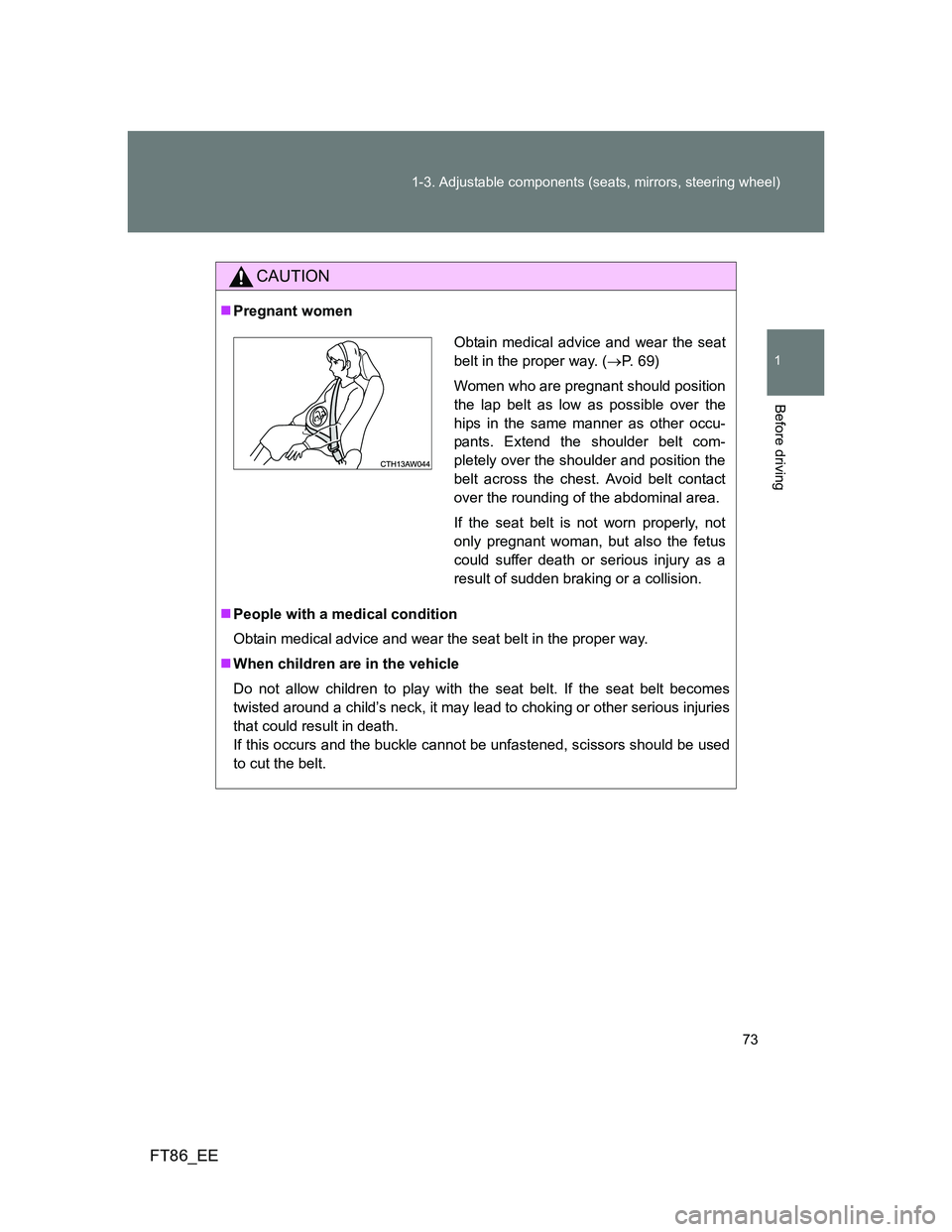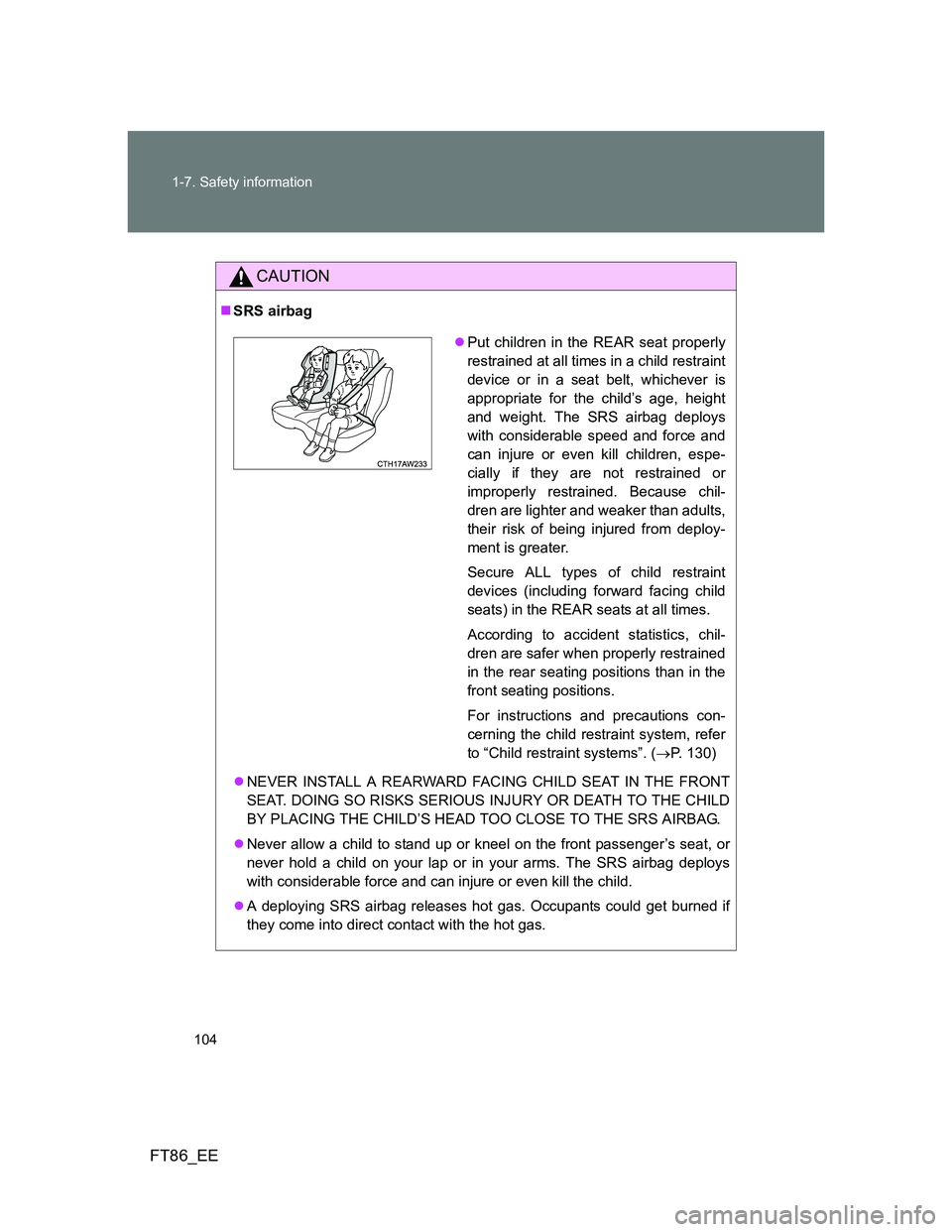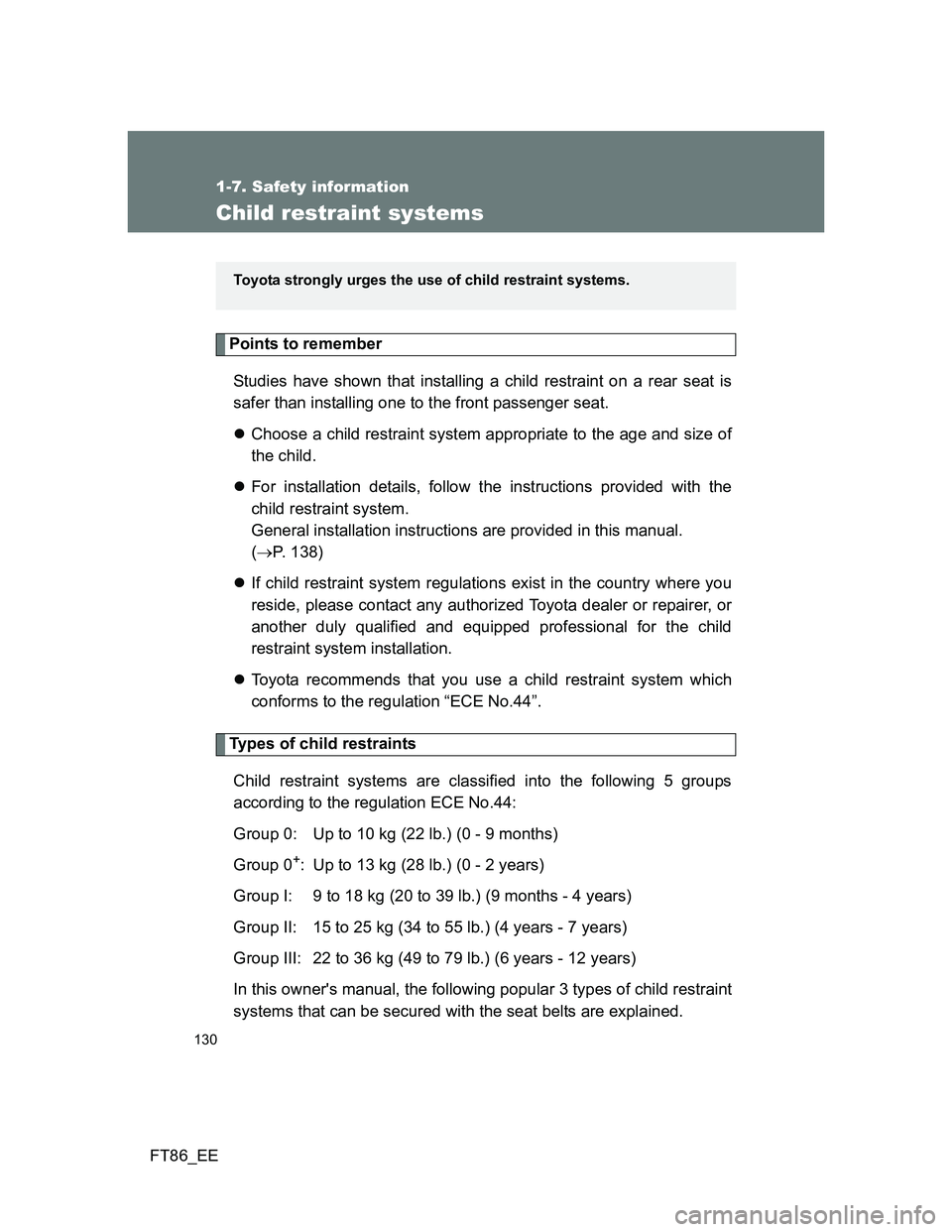Page 73 of 452

73 1-3. Adjustable components (seats, mirrors, steering wheel)
1
Before driving
FT86_EE
CAUTION
Pregnant women
People with a medical condition
Obtain medical advice and wear the seat belt in the proper way.
When children are in the vehicle
Do not allow children to play with the seat belt. If the seat belt becomes
twisted around a child’s neck, it may lead to choking or other serious injuries
that could result in death.
If this occurs and the buckle cannot be unfastened, scissors should be used
to cut the belt.
Obtain medical advice and wear the seat
belt in the proper way. (P. 69)
Women who are pregnant should position
the lap belt as low as possible over the
hips in the same manner as other occu-
pants. Extend the shoulder belt com-
pletely over the shoulder and position the
belt across the chest. Avoid belt contact
over the rounding of the abdominal area.
If the seat belt is not worn properly, not
only pregnant woman, but also the fetus
could suffer death or serious injury as a
result of sudden braking or a collision.
Page 104 of 452

104 1-7. Safety information
FT86_EE
CAUTION
SRS airbag
NEVER INSTALL A REARWARD FACING CHILD SEAT IN THE FRONT
SEAT. DOING SO RISKS SERIOUS INJURY OR DEATH TO THE CHILD
BY PLACING THE CHILD’S HEAD TOO CLOSE TO THE SRS AIRBAG.
Never allow a child to stand up or kneel on the front passenger’s seat, or
never hold a child on your lap or in your arms. The SRS airbag deploys
with considerable force and can injure or even kill the child.
A deploying SRS airbag releases hot gas. Occupants could get burned if
they come into direct contact with the hot gas.
Put children in the REAR seat properly
restrained at all times in a child restraint
device or in a seat belt, whichever is
appropriate for the child’s age, height
and weight. The SRS airbag deploys
with considerable speed and force and
can injure or even kill children, espe-
cially if they are not restrained or
improperly restrained. Because chil-
dren are lighter and weaker than adults,
their risk of being injured from deploy-
ment is greater.
Secure ALL types of child restraint
devices (including forward facing child
seats) in the REAR seats at all times.
According to accident statistics, chil-
dren are safer when properly restrained
in the rear seating positions than in the
front seating positions.
For instructions and precautions con-
cerning the child restraint system, refer
to “Child restraint systems”. (P. 130)
Page 115 of 452
115 1-7. Safety information
1
Before driving
FT86_EE
CAUTION
A warning label
SRS front airbag precaution
Do not touch the SRS airbag system components around the steering wheel
and dashboard with bare hands right after deployment. Doing so can cause
burns because the components can be very hot as a result of deployment.
First impact
Second impact
In an accident where the vehicle is
impacted more than once, the SRS front
airbag deploys only once on the first
impact.
Example: In the case of a double colli-
sion, first with another vehicle, then
against a concrete wall in immediate suc-
cession, once the SRS front airbag is
activated on the first impact, it will not be
activated on the second.
A warning label as shown above is
attached to the sun visor.
This warning label means “Extreme Haz-
ard! Do not use a rearward-facing child
restraint on a seat protected by an airbag
in front of it!”.
Page 123 of 452

123 1-7. Safety information
1
Before driving
FT86_EE
CAUTION
SRS airbag precautions
• Slightly recline the back of the seat. Although vehicle designs vary,
many drivers can achieve the 250 mm (10 in.) distance, even with the
driver seat all the way forward, simply by reclining the back of the seat
somewhat. If reclining the back of your seat makes it hard to see the
road, raise yourself by using a firm, non-slippery cushion, or raise the
seat if your vehicle has that feature.
• If your steering wheel is adjustable, tilt it downward. This points the air-
bag toward your chest instead of your head and neck.
The seat should be adjusted as recommended above, while still maintain-
ing control of the foot pedals, steering wheel, and your view of the instru-
ment panel controls.
The SRS front passenger airbag also deploys with considerable force, and
can cause death or serious injury especially if the front passenger is very
close to the airbag. The front passenger seat should be as far from the air-
bag as possible with the seatback adjusted, so the front passenger sits
upright.
Improperly seated and/or restrained infants and children can be killed or
seriously injured by a deploying airbag. An infant or child who is too small
to use a seat belt should be properly secured using a child restraint sys-
tem. Toyota strongly recommends that all infants and children be placed in
the rear seats of the vehicle and properly restrained. The rear seats are
safer for infants and children than the front passenger seat. (P. 130)
Do not sit on the edge of the seat or
lean against the dashboard.
Page 124 of 452
124 1-7. Safety information
FT86_EE
CAUTION
SRS airbag precautions
Do not allow a child to stand in front of
the SRS front passenger airbag unit or
sit on the knees of a front passenger.
Do not allow the front seat occupants to
hold items on their knees.
Do not lean against the door, the roof
side rail or the front, side and rear pil-
lars.
Do not allow anyone to kneel on the
passenger seat toward the door or put
their head or hands outside the vehicle.
Do not attach anything to or lean any-
thing against areas such as the dash-
board, steering wheel pad or lower
portion of the instrument panel.
These items can become projectiles
when SRS driver, front passenger and
knee airbags deploy.
Page 130 of 452

130
1-7. Safety information
FT86_EE
Child restraint systems
Points to remember
Studies have shown that installing a child restraint on a rear seat is
safer than installing one to the front passenger seat.
Choose a child restraint system appropriate to the age and size of
the child.
For installation details, follow the instructions provided with the
child restraint system.
General installation instructions are provided in this manual.
(P. 138)
If child restraint system regulations exist in the country where you
reside, please contact any authorized Toyota dealer or repairer, or
another duly qualified and equipped professional for the child
restraint system installation.
Toyota recommends that you use a child restraint system which
conforms to the regulation “ECE No.44”.
Types of child restraints
Child restraint systems are classified into the following 5 groups
according to the regulation ECE No.44:
Group 0: Up to 10 kg (22 lb.) (0 - 9 months)
Group 0
+: Up to 13 kg (28 lb.) (0 - 2 years)
Group I: 9 to 18 kg (20 to 39 lb.) (9 months - 4 years)
Group II: 15 to 25 kg (34 to 55 lb.) (4 years - 7 years)
Group III: 22 to 36 kg (49 to 79 lb.) (6 years - 12 years)
In this owner's manual, the following popular 3 types of child restraint
systems that can be secured with the seat belts are explained.
Toyota strongly urges the use of child restraint systems.
Page 131 of 452
131 1-7. Safety information
1
Before driving
FT86_EEBaby seat
Equal to Group 0 and 0
+ of ECE
No.44
Child seat
Equal to Group 0
+ and I of ECE
No.44
Junior seat
Equal to Group II and III of ECE
No.44
Page 132 of 452
132 1-7. Safety information
FT86_EE
Child restraint system suitability for various seating positions
Provided information in the table shows your child restraint system
suitability for various seating positions.
Front passenger seat
Rear seat Airbag manual on-off
switch
ON
OFF
0 (up to 10 kg [22 lb.])X
Never putL3, L4 X
0
+ (up to 13 kg [28 lb.])X
Never putL3, L4 X
I (9 to 18 kg [20 to 39 lb.])Rear-facing
X
Never put
L1 U
Forward-
facing
L1
II, III (15 to 36 kg [34 to 79 lb.]) L2, L5L2, L5
U, L2
Mass groupsSeating position